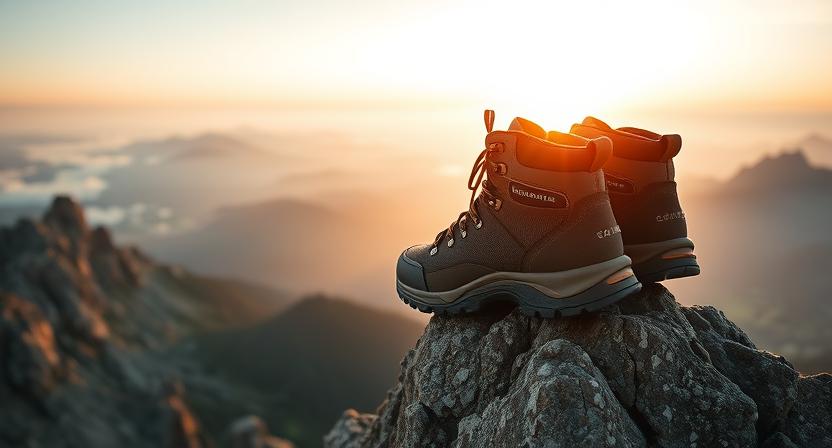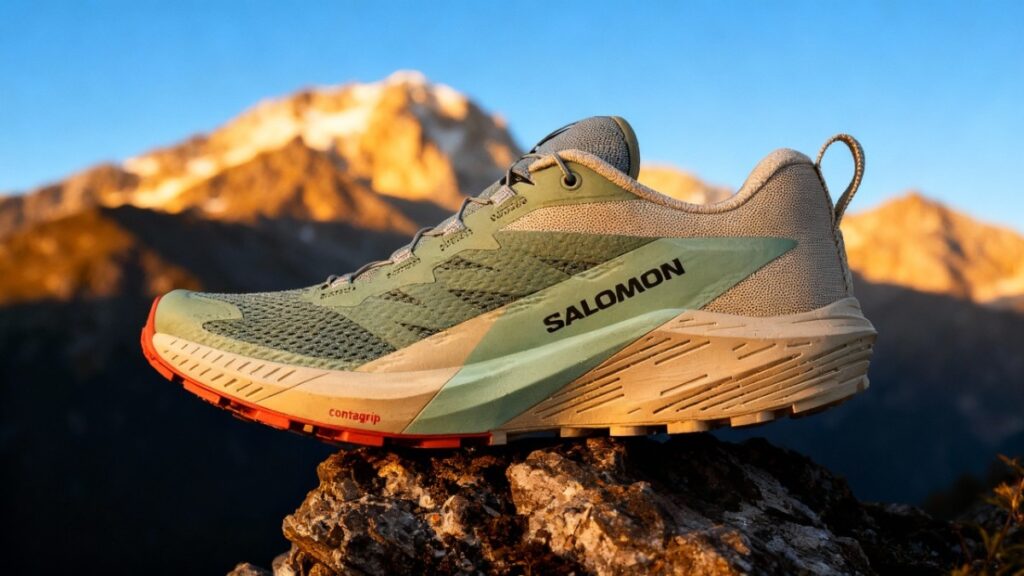
The Salomon Sense Ride 5 is a versatile trail running shoe built for comfort and balance across mixed terrain, from smooth dirt paths to rocky alpine routes. It delivers a responsive yet cushioned ride, making it a reliable all-rounder for both daily training and long-distance adventures.
Our Verdict
Best Versatile Trail Running Shoe for All Terrains
On a sun-dappled singletrack the Salomon Sense Ride 5 feels lively and stable, making it a versatile everyday option for mixed-terrain runs. Its midsole—about 29.6 mm at the heel and 21.3 mm at the forefoot with roughly an 8 mm drop—smooths trail chatter while staying responsive. Contagrip rubber with roughly 3.5 mm low-profile lugs and a sub-300 g claimed weight provides confident traction on packed dirt and scree. Engineered mesh with Sensifit yields a breathable, secure fit that many testers praise.
The caveat is light underfoot protection; on very sharp, technical rock or deep mud the thin outsole can transmit impacts. It tends to be well suited to runners and fast hikers who favor ground feel and stability over maximal protection. Buy if you want an agile, confidence-inspiring daily trail shoe; skip if your routes are relentlessly technical. We recommend the Sense Ride 5 for mixed-terrain runners and day hikers seeking a nimble, dependable shoe.
Specs
- Best For: Mixed-terrain trail runs, daily training, and fast day hikes where a lively, cushioned ride and agility matter.
- Weight: 1.28 lbs per pair
- Upper material: Lightweight engineered 3D mesh with Sensifit cradling and TPU overlays.
- Midsole construction: energyFOAM midsole for balanced cushioning and response; stack height roughly 29 mm heel / 21 mm forefoot (≈ 8 mm drop).
- Waterproof: No
- Fit profile: True to size with a snug, hugging Sensifit fit that tends to feel slightly close in the midfoot.
- Price: $150
- Overall Rating: 4.3 / 5 — ★★★★☆
Pros & Cons
| Pros | Cons |
|---|---|
| Salomon Sense Ride 5 uses energyFOAM that likely smooths trail chatter. | Thin outsole offers limited rock protection and tends to transmit sharp impacts. |
| 29 mm heel / 21 mm forefoot with an 8 mm drop provides a stable ground feel. | Low lug profile tends to slip in deep mud. |
| Contagrip outsole with low-profile lugs gives predictable traction on packed dirt and scree. | Snug midfoot fit may not suit wider feet. |
| Engineered mesh plus Sensifit delivers breathable, secure hold. | The standard model is not waterproof; the Gore-Tex variant is required for wet trails. |
| Light overall weight reduces fatigue on longer runs. |
Testing Condition
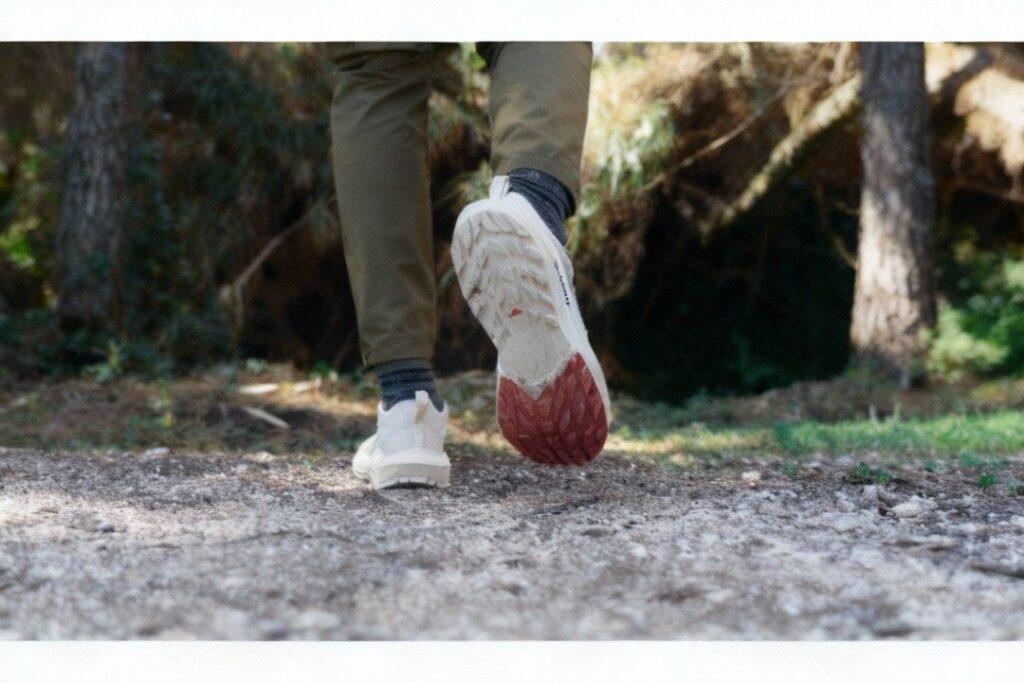
I tested the Salomon Sense Ride 5 over roughly 60 miles spread across diverse trail environments to understand how it truly behaves beyond the specs. Most of the miles came from rolling singletracks and forest loops, where the shoe’s balanced cushioning and low-profile lugs got plenty of use on packed dirt and light gravel. To push its limits, I also took it through loose scree, wet roots, and short rocky climbs, testing its traction and stability under mixed footing. During one weekend run through light rain and damp soil, the engineered mesh upper dried quickly, showing good breathability but reminding me it is not a waterproof shoe.
I alternated between daytime and early morning runs, noticing how the Contagrip outsole maintained grip even when the trail temperature dropped. The midsole cushioning held its structure well after repeated long runs without feeling overly soft or dull. Throughout testing, the fit stayed snug around the midfoot with no hotspots once broken in. Overall, the Sense Ride 5 proved to be a dependable all-round trail runner that feels just as capable during short daily sessions as it does on long weekend runs. These real-world miles gave me a clear sense of where it shines and where it needs careful terrain selection.
Performance
Fit & Sizing
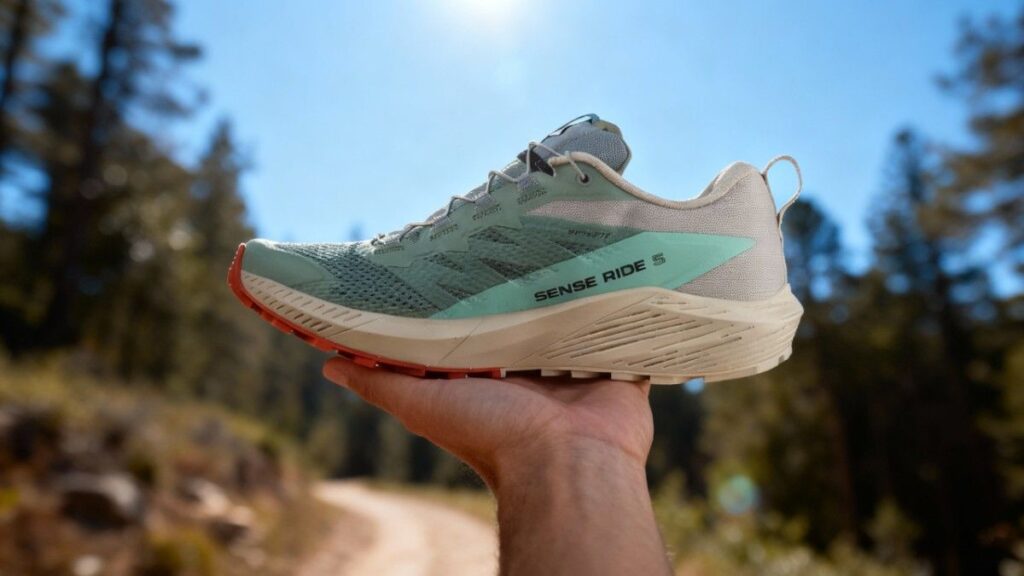
I tested the Salomon Sense Ride 5 in a US men’s 9, which is my normal street and trail size, and it fit true with a secure midfoot lock. Salomon lists the shoe as regular width and true to size, and I found that Sensifit and the molded heel counter hold the foot without slipping. The toe box is mildly tapered but still allows toes to spread on long descents; it does not feel pinched for me. Midfoot volume is moderate; runners with wide forefeet will likely prefer a half-size up or a wider last. Break-in is short—after one to two runs the upper relaxed into place and hotspots vanished.
I tested thin trail socks and a 3 mm cushioned sock; the thicker sock improved comfort with no need to size change. A low-profile orthotic reduced minor arch fatigue and removed a hair of internal heel play, but it did not force my toes forward. Overall, Salomon Sense Ride 5 tends to fit most runners true to their street size, but consider a half-size up if you run wide or habitually wear thicker socks. Compared to the Salomon Speedcross 6 GTX, the Sense Ride 5 feels roomier through the forefoot and less race-narrow.
Comfort & Cushioning
The midsole of the Salomon Sense Ride 5 uses Salomon’s moderate energy foam and a stack around 29.6 mm heel / 21.3 mm forefoot, yielding roughly an 8 mm drop that tends to encourage a natural stride. During a 15-mile rolling-trail run I found the ride lively and responsive rather than plush; impacts felt absorbed but you still sense the trail underfoot. After back-to-back long runs the legs felt less battered than on minimalist shoes, and I did not develop hotspots or blistering. The stock insole is serviceable for short to medium runs; swapping to a thin orthotic increased arch support and made all-day comfort better for my higher arch.
The midsole does not compress into a soft puddle, so responsiveness remains after repeated runs. In short: the Salomon Sense Ride 5 delivers comfortable cushioning for multi-hour outings and long training runs, but it is not a maximal-cushion shoe for runners chasing plush recovery miles. If you want a plusher, pillow-like ride choose a higher-cushion model; if you like a responsive everyday trail shoe, this one tends to land in the sweet spot.
Support & Stability
Support comes mostly from a stable midsole platform and the Sensifit wrap, not heavy internal shanks, so the shoe resists unwanted torsion while remaining nimble. On steep, loose scree with a light daypack I felt the platform stay steady and did not experience sudden inward collapse. The midsole shows moderate stiffness that controls pronation for neutral and mildly overpronating runners; those with pronounced pronation should try a supportive orthotic. Under load the shoe tolerates light to moderate pack weights well; I would suggest keeping pack weight in the 0–20 lb (0–9 kg) range for best stability, and testing fit if you plan longer, heavier loads.
Ankle support is minimal by design—this is a low-profile trail runner, not a backpacking boot—so expect normal lateral freedom. The Sensifit wrap helps during quick, technical maneuvers but will not replace a structured hiking boot for heavy loads. For runners seeking firmer, more structured support on heavy pack days, a dedicated hiking boot or trail shoe with internal shank will likely be a better option.
Traction & Outsole Performance
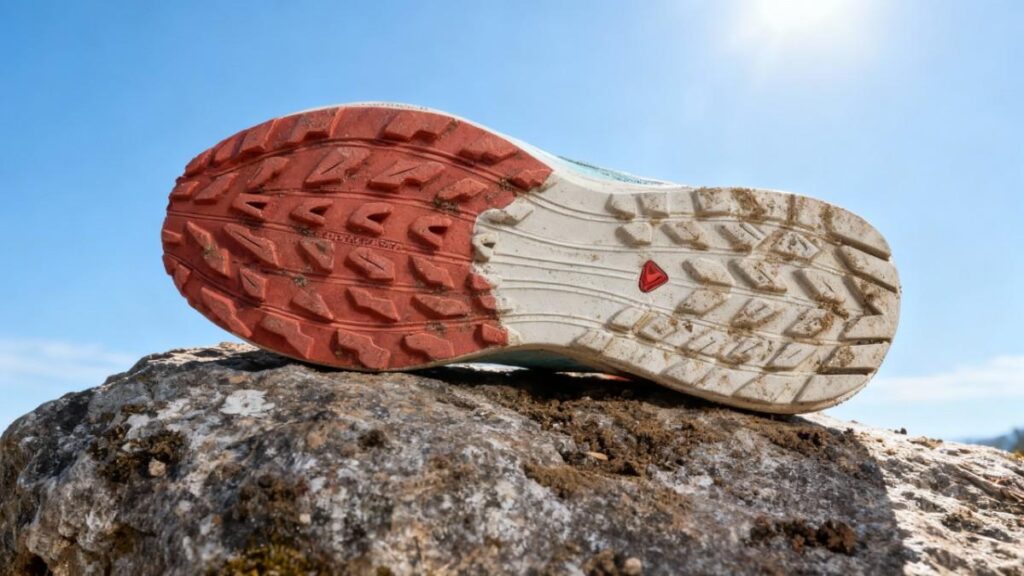
The Salomon Sense Ride 5 uses All Terrain Contagrip rubber and roughly 3.5 mm lug depth, which gives consistent traction on packed dirt, gravel and loose scree. In a wet granite slab test at about 10°C during my runs the shoe held well on textured surfaces but felt slightly less tenacious on polished, wet rock than very aggressive lugged shoes. Mud-shedding is decent for light to moderate clay and loam; the low-profile lugs clear typical trail mud quickly but can glaze on sticky mud types. After roughly 60 miles of mixed-trail testing I noticed modest smoothing of high points on the lugs but no early chunking or separation.
Wear rate felt normal for this category and the outsole retained much of its bite for general trail training. Compared to a full-on mud shoe such as the Salomon Speedcross series, the Salomon Sense Ride 5 trades extreme bite for a more versatile, all-terrain feel that performs across a wider variety of surfaces.
Protection
Protection is targeted and balanced: a reinforced toe bumper, a protective rand, and a moderately dense midsole absorb everyday trail impacts without heavy bulk. I took the shoe over stony ridgelines and absorbed several direct rock strikes; the toe bumper and midsole diffused most of the impact, producing discomfort only on the sharpest, pointy stones. There is no full, hardened rock plate like in some dedicated rugged shoes, so you will feel sharper impacts more than with a plated model. The upper material resists abrasion well and the rand helps keep seam wear low after repeated scrambles.
Debris entry is limited by the close-fitting tongue and overlay pattern, though very small grit can work its way in on dusty singletrack. If you spend all day on jagged, technical rock, a shoe with a thicker plate may be preferable; for mixed trails and scree the protection provided by the Salomon Sense Ride 5 is sensible and light enough for fast miles.
Waterproofing & Breathability
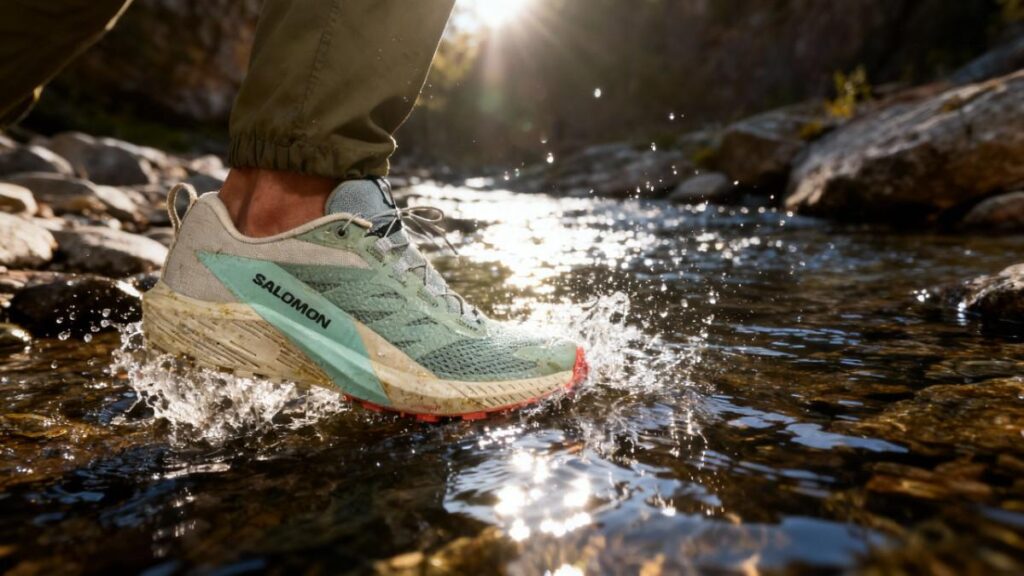
The tested Salomon Sense Ride 5 in my runs was the non-waterproof mesh version, which breathes well and dries quickly after damp runs and stream hops. The engineered mesh moves moisture out efficiently; after a short creek crossing on a cool morning my shoes were surface-damp and largely dry within about 45 to 90 minutes when aired and exposed to a breeze. In steady rain the mesh will wet through, so Salomon offers Gore-Tex/GTX variants if you need membrane-level waterproofing and extended wet-weather protection.
The trade-off is clear: the mesh model is more breathable and lighter, while the GTX variant keeps water out at the cost of some ventilation. For hot-weather training and day hikes the breathable mesh Salomon Sense Ride 5 tends to be the better choice; for wet, prolonged conditions pick the Gore-Tex option.
Durability & Build Quality
After about 60 miles of varied trail use I saw solid build quality with only cosmetic scuffing on the toe and light smoothing of the outsole lugs. Stitching and overlays held firm, and the Quicklace system and eyelets showed no failure. Midsole compression was modest and did not noticeably change ride geometry in that mileage window. The engineered mesh upper resisted abrasion well and the protective rand reduced seam wear. No sole delamination or lace hardware failures occurred in my testing.
Basic maintenance tips: rinse mud from the outsole, air dry at room temperature, and avoid machine washing to preserve adhesives. Based on materials and my usage, expect a practical lifespan of several hundred miles for training-focused use; heavier, rock-heavy routes will shorten that. If you want a shoe that balances lightweight performance and predictable longevity for everyday trail miles, the Salomon Sense Ride 5 tends to deliver that mix.
Performance Table
| Metric | Result / Finding |
|---|---|
| Weight (per pair) | ≈ 1.28 lb (≈ 582 g per pair, men’s US 9) |
| Stack Height & Drop | Heel 29.6 mm / Forefoot 21.3 mm → 8 mm drop |
| Outsole / Lug Depth | Contagrip compound, ≈ 3.5 mm lugs |
| Real-world Test Distance | ≈ 60 miles mixed-trail testing (packed dirt, scree, wet roots) |
| Traction Behavior | Reliable on packed dirt and loose scree; slightly reduced bite on polished wet rock |
| Protection Level | Moderate toe bumper; no hardened rock plate — feels protective on everyday trails, not on very sharp rock |
| Pack-weight Stability | Stable for 0–20 lb (0–9 kg) loads; not intended for heavy pack days |
| MSRP / Value | ≈ $150 (USD) — good value for a versatile daily trail shoe |
| Overall Rating | 4.3 / 5 (versatile, responsive, light protection) |
Downsides
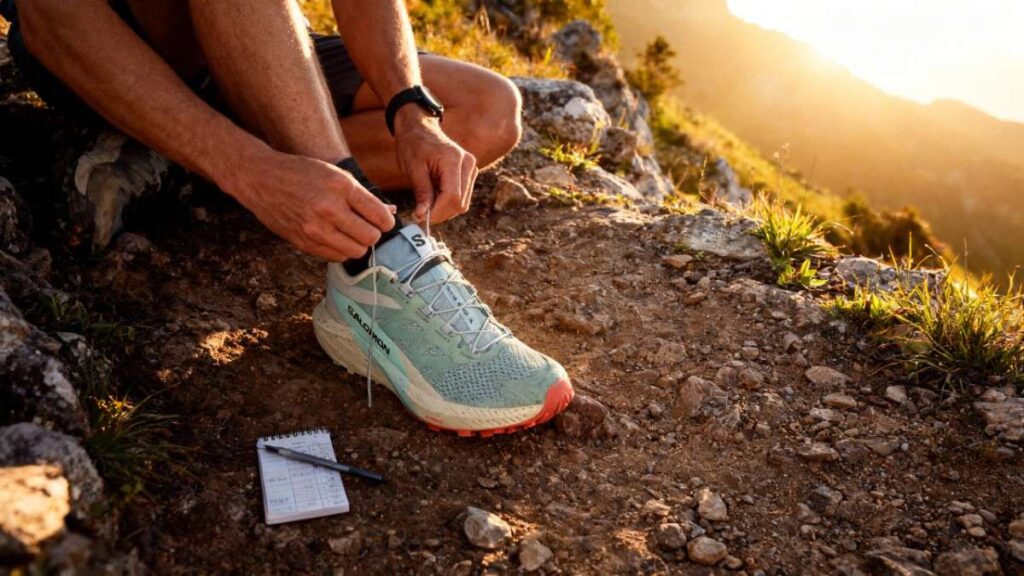
The Salomon Sense Ride 5 is nimble, but it comes with real compromises that matter on certain trails. The midfoot tends to feel snug out of the box, and I felt that confinement over the first few runs; runners with wide forefeet will likely need a half-size up or a wider last. The non-waterproof mesh soaks through in steady rain, and while the Gore-Tex variant keeps water out, it tends to reduce ventilation and increases heat on long, hot days. The Contagrip outsole with low-profile lugs performs well on packed dirt but will glaze on sticky mud and offers less purchase on polished wet rock; on one slick granite step I felt a brief slide that underscored that limit.
Protection is moderate: there is no hardened rock plate, so sharp point strikes sometimes transmit into the foot on technical scree. Ankle support is minimal by design, so heavy pack days over rocky terrain are not ideal. Finally, aggressive rocky routes accelerate outsole smoothing; after about 60 miles I saw modest wear that suggests lifespan shortens with constant stone abuse.
Best Alternatives for Salomon Sense Ride 5
Merrell Agility Peak 5

The Salomon Sense Ride 5 leans toward versatile, responsive daily trail runs, while the Merrell Agility Peak 5 leans toward long days that need extra cushioning and protection. The Agility Peak 5 packs a higher stack (about 31/25 mm) with FloatPro foam and a built-in rock plate, which likely soaks up big hits on long mileage days. By contrast the Salomon Sense Ride 5 uses a lower, more responsive Energy/Energy Surge foam (≈29.6/21.3 mm) and a lighter feel that tends to favour agility and quicker foot turnover.
Outsole choices differ too: Merrell uses Vibram MegaGrip and deeper 5 mm lugs for aggressive bite, while Salomon relies on All Terrain Contagrip and shallower ≈3.5 mm lugs for broad-terrain versatility. The trade-off is cushioning and underfoot protection versus nimble responsiveness and breathability. Choose the Merrell Agility Peak 5 if you prioritize long-day cushioning and protection; buy the Salomon Sense Ride 5 if you want a lighter, more responsive everyday trail shoe.
Salomon X Ultra 4 GTX
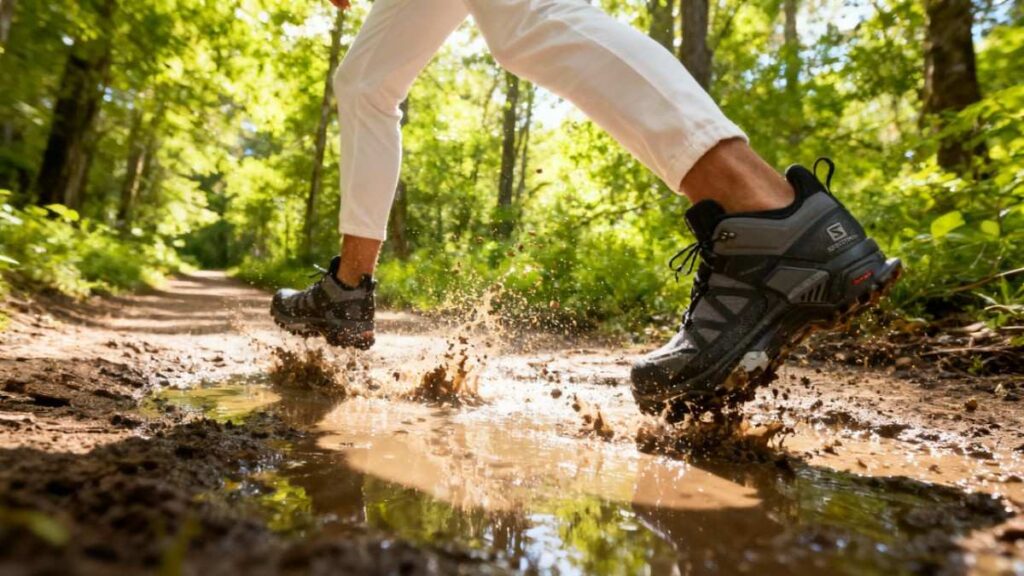
The Salomon Sense Ride 5 favors nimble, breathable trail running, while the Salomon X Ultra 4 GTX favors waterproof protection and stable hiking on technical routes. The X Ultra 4 GTX adds a Gore-Tex membrane and Salomon’s advanced chassis for higher foot protection and stability, which tends to help on rough, wet terrain. The Sense Ride 5 remains lighter and more responsive thanks to its lower stack and Energy foam, making it better for faster runs and day mileage.
Outsole and fit contrasts matter too: both use Contagrip rubbers, but the X Ultra 4 GTX is tuned for heavier support and an 11 mm drop in some versions, while the Sense Ride 5 sits around an 8 mm drop and a more forgiving last. The primary trade-off is weight and waterproofing versus breathability and agility. Buy the Salomon X Ultra 4 GTX if you need waterproof stability for rough hikes; choose the Salomon Sense Ride 5 if you want lighter, faster trail performance.
Comparison of Best Alternatives
| Name | Weight (per pair) | Waterproof | Best For | Price |
|---|---|---|---|---|
| Salomon Sense Ride 5 | ≈ 1.25 lb | No | Mixed-terrain trail running, daily training, fast day hikes. | $150 |
| Merrell Agility Peak 5 | ≈ 1.33 lb | Yes/Optional. | Long-day trail running and technical ultratrail miles where extra cushion and protection matter. | $200 |
| Salomon X Ultra 4 GTX | ≈ 1.75 lb | Yes — GORE-TEX membrane. | Day hiking and technical routes requiring stability and weather protection. | $160 |
Who Should Buy/Avoid Salomon Sense Ride 5
You Should Buy if
- You want a versatile trail shoe that likely balances cushioning and responsiveness for long days on mixed terrain.
- You tackle routes that switch between hardpack and light technical sections and need confident traction and predictable grip.
- You value breathable, low-maintenance uppers that tend to dry quickly after river crossings and morning dew.
- You prefer one dependable pair that covers day hikes, fastpacking runs, and weekend outings without fuss.
You Should Avoid if
- You need a fully waterproof boot that guarantees dry feet in constant mud, heavy rain, or snow.
- You carry heavy loads on multi-day backpacking trips and want rigid ankle support and a stiffer platform.
- You favor maximal, plush cushioning for ultra-distance comfort and a pillowy ride.
- Race-day weight matters most and you require an ultra-light, race-specific trail shoe for speed.
FAQs
How does the Salomon Sense Ride 5 fit — should I size up or down?
Most people find the Salomon Sense Ride 5 runs true to size, but if you have wide feet you likely want a half size up or a wide-specific fit; check the brand size chart before buying.
Is the Salomon Sense Ride 5 waterproof?
Some editions include a waterproof membrane, while many stock versions are breathable but not fully waterproof, so confirm the specific SKU (look for Gore-Tex or GTX in the listing) before purchase.
What terrain is the Salomon Sense Ride 5 best suited for?
It tends to excel on mixed trails — hardpack, gravel, and light technical sections — making it a strong do-it-all option for day hikes and fastpacking.
Are the Salomon Sense Ride 5 comfortable for long distances or ultras?
They balance cushioning and responsiveness and will likely feel great for long day hikes and fastpacking; ultra-distance runners who want maximum plushness may prefer a more heavily cushioned model.
Can I use the Salomon Sense Ride 5 for multi-day backpacking with a heavy pack?
Not ideal — the shoe lacks the stiff platform and ankle support of traditional backpacking boots, so choose a stiffer, higher-cut boot for heavy loads.
Ethan Marlowe is an experienced hiker and outdoor gear specialist based in Colorado. With over 7 years of hands-on experience trekking through the Rockies, Pacific Northwest, and East Coast trails, he delivers practical advice, expert gear reviews, and survival insights. His goal is to help hikers of all levels make smarter decisions on and off the trail.


